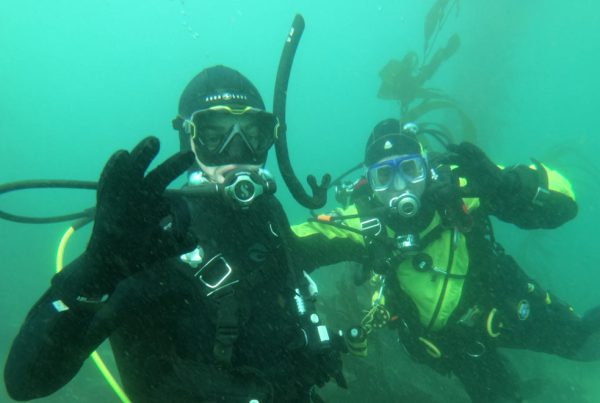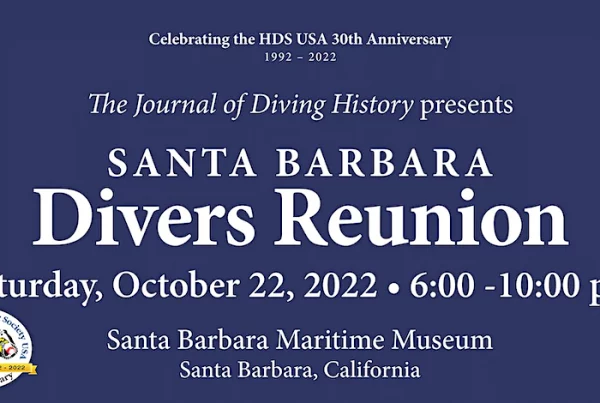
A glass globe of the earth sitting in sand of a beach with waves crashing in the background.
California divers thrive on new. We love learning about the latest in gear, the most recent ocean science discoveries and we’re always craving new underwater experiences — especially new and exciting dive sites.
Exploring a new dive site is a thrill. In many cases we gain a sense of accomplishment — and bragging rights — when we enter a new dive location into our logbooks. Even when the site is “new to us” rather than a site previously unknown to the diving world, this is the stuff that sparks our sense of adventure.
This article will help you develop and hone your exploration skills as you discover more of what California diving has to offer.
Getting Started
Every good diver knows that proper training and equipment are paramount before you set out as a scuba diver. Getting an Open Water Diver certification card is only a first step. It lays the foundation onto which you’ll build your skill set. Consider what type of diving you might like to experience. This will point you toward the various learning opportunities — formal classroom instruction, workshops, seminars and learn-by-doing options — available near you.
Beach diving, for example, can be quite rewarding if you are prepared and experienced. Before you go charging through the surf on your own, you’d do well to get some practical experience with a group, club, a seasoned individual (preferably an instructor) or professional dive center.
San Diego and Los Angeles County divers can take advantage of a summer training series known as the 3Rs: Rocks, Reefs, and Rips. These workshops are held at various beach dive sites throughout the summer. Each session runs for a few hours and includes brief lectures and supervised in-water training. For more information visit lacscuba.com/3rs or sddivers.com/3rs.
Some charter boats schedule “beginning boat diver” charters during which they offer detailed briefings and demonstrations that will help you get your sea legs.
If underwater hunting or photography/video is your thing, you might want to check out hunting/freediving clubs and underwater photo workshops that will help you increase your knowledge and skills.
Site Studies
One of the “side effects” of becoming a scuba diver is that you’ll likely find yourself becoming obsessed with underwater topography. Maybe it’s a thing you never considered before, but you might start spending time looking at nautical charts or scrolling Google Earth and bookmarking various NOAA (National Oceanic and Atmospheric Administration) web pages as your fascination with what a dive site’s underwater features are like. There’s no cure for this, but you’ll be happy to learn the resources are plentiful. And they aren’t all on the Internet. Guidebooks and magazine articles are also helpful, including the Dive Spotlight articles published in each issue of California Diving News.
Perhaps your best resource is word of mouth and there are two excellent places to draw from for that information — your local professional dive center and dive clubs. I have gathered more material standing around waiting for my tank to be filled than practically any other source. Your local bait and tackle shop can also serve as a good resource. Some of the best fishing sites double as great dive sites. Just keep an eye out for fishing line and make sure you have a cutting device when exploring areas favorited by fishers.
When out on the water, look for clues that an area might be worth investigating. Rocky outcroppings, kelp that rises to the surface, and seabirds converging over an area all are indicators of a potential hotspot. The same is true for large “floaty things” like a seaweed patch or a big log. These things naturally attract marine life and might be worthy of a quick look-see.
When planning to explore an unknown site, make sure you pay attention to all potential hazards — boat traffic, currents, depths, etc. It’s important to be properly equipped and use good common sense at all times while diving — but especially when in new/unfamiliar areas.
Go With the Pros
Perhaps you’re more comfortable leaving the planning to the pros. There’s certainly nothing wrong with that! A dive charter operator will be choosing a dive site based on a number of factors including experience levels of those aboard and prevailing conditions including wind, waves, water clarity, reports of recent marine life sightings and more.
Keep in mind that as the client it’s perfectly acceptable to request that the boat visits a particular site. Before doing so, learn about the area so you can make an informed request. Just asking in general for someplace new is likely not to cut it. Even better is to frame your request on a particular activity, underwater feature or animal. For example, I once was on a charter boat and mentioned I’d never gotten a decent photo of an angel shark. The boat pulled into a particular cove at Santa Barbara Island. The skipper pointed into the water below and simply said, “There.” As I dropped down on the site I nearly landed on a six-footer!
The skipper and crew are there to see that you have a safe, fun experience. It’s their job. But part of your job is to be a well-informed charter client before you board the boat. Before ever purchasing a boat ticket ask two important questions — what is the destination? And how many individual sites will be visited?
What is your planned destination? A lot of boats, charter groups, clubs and shops publish their planned goal destinations ahead of time. Some are quite specific on the sites to be visited. But there are never any guarantees. Shifts in weather, other boats crowding the site, and changes in water conditions can change plans.
How many individual sites will be visited? This is different than how many tanks or how many dives will be available. Three dives in a day are great but if they all in the same spot, the possibility of having a fresh underwater experience each dive is reduced.
Re-New the Site
Even if your dive trip is to a place you’ve visited before, with the right mindset you can gain a fresh vantage point on an already-been-there site.
Look up and out. Often we spend so much time rapidly cruising over a reef so as to cover as much bottom at possible. Look up! It is here you will sometimes see schools of fish, a sea lion or harbor seal, dolphins, even a whale! The same goes for looking up and outward away from the reef or wall. Look for rays, molas, turtles, sharks, jellies, and schools of squid drifting by in the current.
Stay shallow. Lobsters often abound in the eelgrass surging in 10 feet or less. When exploring the shallow sand flats, away from the reefs and walls, you’ll likely find halibut, bat rays and soles. You will however have to be comfortable with sometimes-strong surge and have excellent control of your buoyancy, but shallow areas offer some great marine life encounters.
Go deep. This is a bit tougher as you’ll have to have proper training, experience and equipment. It is remarkable what you’ll see and in the near shore deep submarine canyons.
Explore the sand away from the reef. To many divers, the sand appears to be a desert. Wrong. The sand biome is home to sand dollars, mantis shrimp, sand stars, sea pens, and sea pansies. All are creatures you’d never see on the reefs.
Look for the random rock. There is another advantage to venturing off across the sand. You may, and often will, find the unexpected. Sometimes it is just a small rock, other times a massive pinnacle. Or perhaps you will find a small wreck or other random debris that will make up a mini-reef. Working away from the main dive site my buddy and I once found an unknown small wreck that was chock full of good-sized lobster.
Look for the tiny. Marine life in our California seas come is all shapes, types and sizes. If you move in slow motion and scour the ocean floor with a good-quality magnifying glass, you’ll amazed at the tiny creatures you might have missed while finning to get to the “good stuff.”
Often dive sites are bypassed with the mistaken thought of “been there, done that.” But so many locations have more than one dive site. They have more than one area to explore, sometimes three or more. Shaw’s Cove in Laguna Beach is one example. Due to the incredible and fun feature known as “The Crevice” this is a popular beach diving spot. But the outer reef here is even better and extends a long way out.
Yet another example is Malaga Cove where the sweeping ivory sands of the Santa Monica Bay meet the rocks of the Palos Verdes Peninsula. Here you can dive the main area, Haggerty’s down a stone’s throw and the RAT beach reefs just a few steps up the beach. Perhaps you need to bring more tanks.









